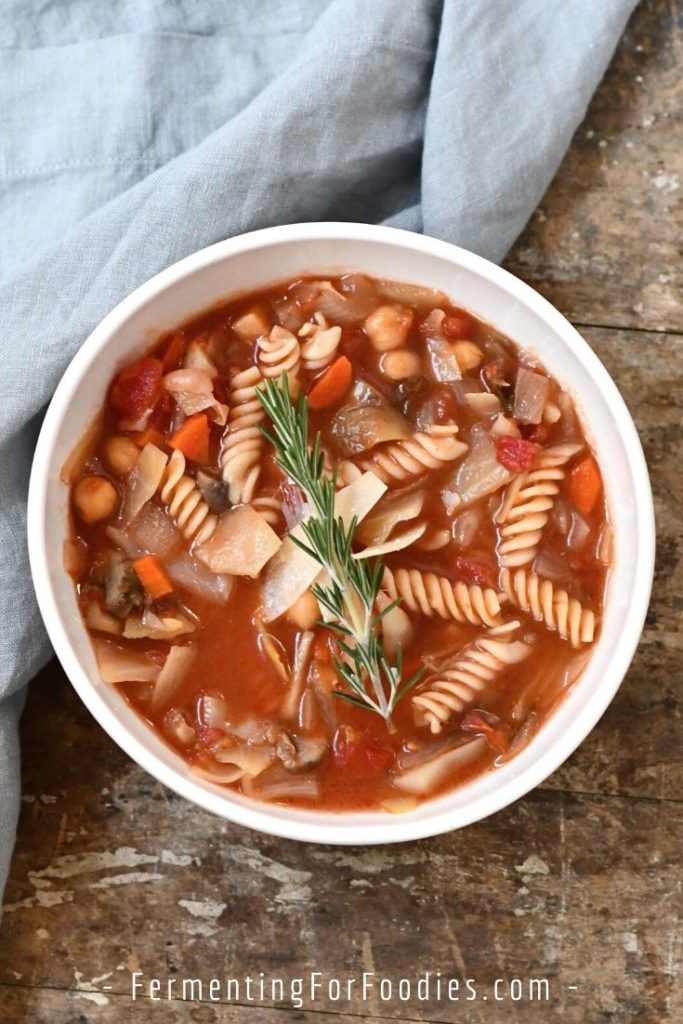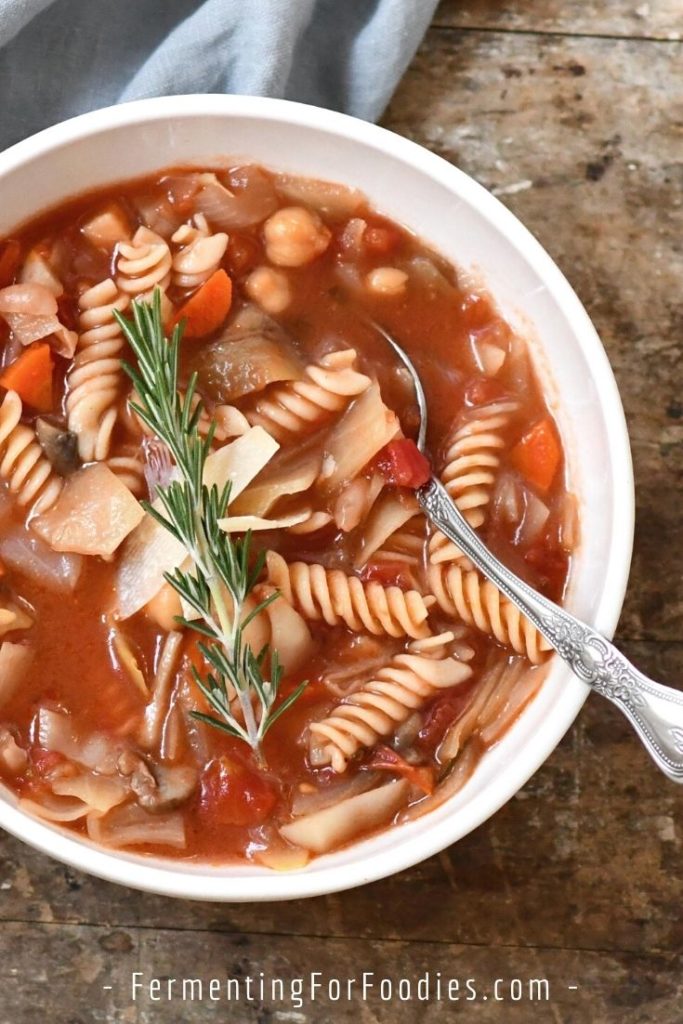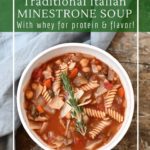The secret to amazing vegetarian minestrone is the addition of whey. It adds flavor, richness, and protein to the hearty mix of beans, pasta, and vegetables.

Types of Whey
Traditional minestrone soup would have been made with whey from Parmesan or Romano cheese. It is also delicious with slightly more acidic whey from kefir cheese or Greek yogurt.
Just avoid using whey from making non-cultured cheese (like paneer or ricotta). The added lemon juice, vinegar, or citric acid will add too much acidity to this soup. If you aren’t sure what type of whey you have, check out this post on types of whey for more information.
Clean out your pantry
Minestrone soup is the perfect clean-out-your-pantry soup. It is one of those hearty soups that can easily be customized for whatever you happen to have in your kitchen. It’s also easy to make it gluten-free or vegan.
Here are a few ways to customize this simple minestrone soup:
- Gluten-free: This soup is easy to make gluten-free, just use gluten-free pasta!
- Vegan: Whey and Parmesan are not necessary to give this soup richness. Feel free swap it for your favorite vegetable broth.
- Mix and match vegetables: Pretty much any kind of vegetable will work in this soup. Use whatever is in season. Kale, chard, zucchini, fennel, and root vegetables are all delicious in this soup.
- Beans and more: Traditional minestrone was made with whatever beans and lentils were available. It doesn’t have to be chickpeas. Just use whatever you have on hand.
- Toppings: I love adding toppings to this soup. Serve it with a spoonful of pesto, diced kalamata olives, or garlic croutons.

Traditional Whey Minestrone Soup
Traditional minestrone soup often is made using leftover whey from cheesemaking. It adds richness and protein to this hearty vegetarian soup.
- Prep Time: 15 minutes
- Cook Time: 30 minutes
- Total Time: 45 minutes
- Yield: Serves 6-8 1x
- Category: Soup
- Cuisine: Italian
- Diet: Vegetarian
Ingredients
- 4 Tbsp olive oil
- 1 large onion, finely diced
- 2 medium carrots, diced
- 3 celery, including leaves, finely diced
- 1/2 head of cabbage, chopped into bite-sized pieces
- 1 cup mushrooms, thinly sliced
- 5 cups total liquid, a mix of water and whey (or broth, see notes)
- 1 large (28 oz) can of chopped tomatoes
- 1 (15 oz) can of chickpeas or 1 1/2 cups of cooked chickpeas
- 1 sprig of fresh rosemary (1 tsp dried)
- 1/4 cup chopped fresh basil (1 tsp dried)
- 1/4 cup chopped fresh parsley (1 tsp dried)
- 1 tsp salt, to taste
- 1 cup pasta
- 1/4 cup of fresh grated Parmesan
Instructions
- Heat the olive oil in a large pot. Add vegetables and saute on medium until the onions are tender, about 5 minutes.
- Add in the water, whey, tomatoes, beans, and herbs. Bring everything to a boil, reduce the heat, and simmer for 30 minutes.
- Remove the rosemary sprig and stir in the pasta. Simmer until pasta is cooked (about 10 min).
- Season to taste. Serve immediately with a drizzle of olive oil and freshly grated Parmesan cheese.
Notes
- The proportion of whey to water will depend on how fresh and sweet the whey is. If you have sweet whey from making a hard cheese, feel free to use the full 5 cups, with no additional water. For acid whey (usually from fresh cheese) use between 1-2 cups of whey. The flavor of whey should be subtle, so don’t overdo it. If you aren’t sure, then taste the whey and dilute it until it’s palatable. See the section above for more details about the different types of whey.
- If you don’t have whey, then use broth.
- The amount of salt required will depend on whether you use broth or whey. Whey may require a bit more salt. Season lightly, then add salt to taste.
Nutrition
- Serving Size: 2 cups
- Calories: 332
- Sugar: 20g
- Sodium: 573mg
- Fat: 12.2g
- Saturated Fat: 2.2g
- Carbohydrates: 49.6g
- Fiber: 9.9g
- Protein: 10.1g
- Cholesterol: 5mg



I spent months living of minestrone as a student! So easy and satisfying, and makes exceptional leftovers!